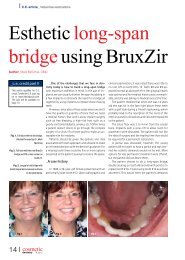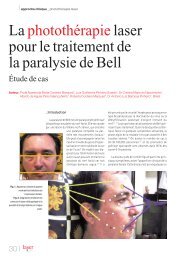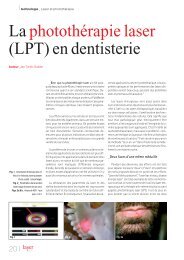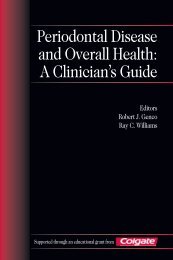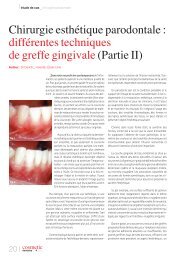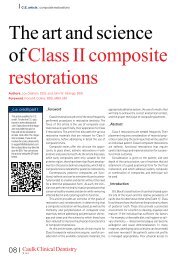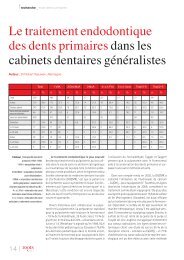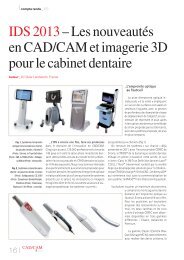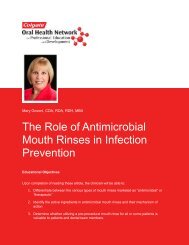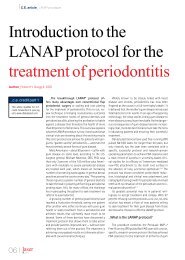Periodontal Disease and Overall Health: A Clinician's Guide
Periodontal Disease and Overall Health: A Clinician's Guide
Periodontal Disease and Overall Health: A Clinician's Guide
Create successful ePaper yourself
Turn your PDF publications into a flip-book with our unique Google optimized e-Paper software.
48 <strong>Periodontal</strong> <strong>Disease</strong> <strong>and</strong> <strong>Overall</strong> <strong>Health</strong>: A <strong>Clinician's</strong> <strong>Guide</strong>bacterial products found in the mouth couldenter the bloodstream <strong>and</strong> could in some waybe harmful to the body as a whole. 29 It wasnot until the last decade of the twentieth centurythat dentistry <strong>and</strong> medicine started againto consider the relationship of oral diseases,such as periodontal disease, as a contributorto risk factors for certain systemic diseases.Oral-Systemic Relationship RevisitedThe late 1980s saw an increasing numberof publications implicating an associationbetween periodontopathogenic bacteria <strong>and</strong>certain systemic conditions such as coronaryartery disease, stroke, <strong>and</strong> preterm/low birthweight babies. Such insinuations had alsobeen made early in the twentieth century, butthis time reports were judged with a moremeasured response. 30 According to Barnett 30this response was a result of several factors:(a) greater analytical <strong>and</strong> statistical knowledge,<strong>and</strong> a better underst<strong>and</strong>ing of the con -strains of epidemiological research in “estab -lishing disease causalty”; (b) increased aware -ness of the etiology <strong>and</strong> pathogenesis of oraldiseases; (c) increased awareness of theetiology <strong>and</strong> pathogenesis of associated systemicdiseases; (d) modern advances in thetreatment of oral conditions; (e) realizationthat bacteria could in some way be implicatedin the development of diseases that asyet have an undetermined etiology.In 1989, Mattila <strong>and</strong> coworkers 31 inFinl<strong>and</strong> conducted a case-control study on100 patients who had suffered an acute myocardialinfarction. They compared these patientsto 102 control subjects selected fromthe community. A full dental examinationwas performed on all of the subjects studied.Additionally, a dental index was computed.This index computed the sum of scores fromthe number of missing teeth, carious lesions,peri-apical lesions, probing depths, <strong>and</strong> thepresence or absence of pericoronitis. It wasfound that dental health was significantlyworse in patients with a history of acutemyocardial infarction than in control subjects.This association remained valid evenafter adjustment for age, social class, smoking,serum lipid concentrations, <strong>and</strong> the presenceof diabetes. It was mainly this studythat renewed the interest of physicians <strong>and</strong>dentists in the relationship of oral to systemicdisease.In retrospect, it is now clear that theadvent of reports by Mattila <strong>and</strong> colleagues—followed soon thereafter by DeStefano etal. 32 <strong>and</strong> Offenbacher et al. 33 —was the beginningof a new era of underst<strong>and</strong>ing theimpact of oral health <strong>and</strong> disease on overallhealth <strong>and</strong> disease. 25,30 By 1996, the term“periodontal medicine” would emerge asscientists <strong>and</strong> clinicians in dentistry <strong>and</strong>medicine began to appreciate the tremendouseffect that oral disease can have on thebody. 34PERIODONTAL/ORAL DISEASEAS A RISK FACTOR FORSYSTEMIC DISEASEDespite many years of history demonstratingthe influence of oral status on generalhealth, recent decades have seen an acceleratedeffort for the prevention <strong>and</strong> managementof these conditions through groundbreakingadvances. Specifically, periodontitis,a chronic infectious <strong>and</strong> inflammatory diseaseof the gums <strong>and</strong> supporting tissues, hasbeen associated with systemic conditionssuch as coronary heart disease <strong>and</strong> stroke,higher risk for preterm, low-birth-weightbabies, <strong>and</strong> certain cancers. It has also beensuggested that it might pose threats to thosewith chronic disease, e.g., diabetes, respiratorydiseases, <strong>and</strong> osteoporosis. 35-38 Perio -dontal diseases are infections that are causedby micro-organisms that colonize the toothsurface at or below the gingival margin.These infections affect the gingival tissues<strong>and</strong> can cause damage to the supportingconnective tissue <strong>and</strong> bone. <strong>Periodontal</strong> diseasecan be caused by specific bacteria (such



